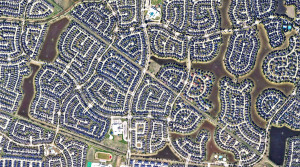
Why suburban layout is a barrier to a walkable city in the United States?
When we talk about urban development in the U.S., there is one word that will always be present in any discussion: the sprawl.
The endless suburbs of the country’s largest cities are the product of decades of urban planning based on the “American way of life”, creating low-density districts, surrounded by nature (or at least meadows) and connected to the financial centres by highways. A “car-oriented” development with consequences that have already been widely studied and which have contributed to the environmental crisis that the world is suffering today.
In contrast to suburban sprawl, different concepts have emerged in recent years that favour a more compact, efficient and less auto-dependent urban model. This is the case of the “15-minute city”, which according with Patrick Sisson from The City Monitor, “the 15-minute city is an approach to urban design that aims to improve quality of life by creating cities where everything a resident needs can be reached within 15 minutes by foot, bike or public transit.” This means that community services such us schools, medical centres and parks, as well as workplaces, should be located at distances that do not require the use of cars or allowing an easy use of public transportation.
In cities like Paris and Amsterdam, with relatively high urban densities, a robust bikeway infrastructure and good transportation networks, the application of the “15-minute city” seems to be a viable alternative. However, in the American suburban model, guaranteeing this efficient and close connectivity is much more complicated, not only because of the low density of these developments, but also because of their spatial configuration.
Most American cities grew from a simple but easily implemented geometric layout: the grid. This configuration allowed a practical orientation in space, as well as relatively easy regulation for subsequent city expansions. However, with the ease of car purchase and the demand for new housing for the growing middle class, residential developments with more “organic” and less grid-like layouts became increasingly popular.
This, of course, was not an American invention. The concept of suburban housing was already developed in the Garden City model since the late nineteenth century, with several examples such as Welwyn Garden City in England or Canberra in Australia. However, it would be in the United States where the suburb would reach its greatest popularization and where it would also deviate more from its initial idea, since the Garden City, more than a purely residential development, was an integral city that could supply most of the basic needs of its residents.The most common layout of American suburbs consists of curving or cul-de-sac streets, which are used almost exclusively by residents to get to and from their homes, creating an environment with low vehicular traffic, which, in principle, generates a quiet and safe environment for its dwellers. However, this design principle has led to formation of residential districts that are poorly connected to local community services, creating long distances even between homes, which are gruelling to walk.
The following cases show how the suburban layout in the U.S. poses major disadvantages for pedestrian accessibility:
Access to community services:
This map shows a suburb located in San Antonio, TX. In this example, the design of the roads forces a person living in the highlighted place to walk more than half a mile to the local elementary school, which is located right next to his or her house.
Access to public transport:
In this scenario, the resident of the house marked on the map lives near to a local bus stop, located in a suburb of Florida. However, due to the layout of his neighbourhood, this person must walk for more than 15 minutes to use public transportation.
Connection between neighbours
This map shows a suburb of Pittsburgh, PA. Because of the street layout, a resident living in the demarcated spot will have to walk for more than half an hour to visit his or her neighbours who lives only 320 ft (97.5 m) away.
The above examples illustrate some of the disadvantages that the suburban layout in the U.S. generates for a more compact and less car-dependent city, as is the case of the “15-minute city”. However, some cities such as Detroit and Portland are already devising proposals to generate more complete and comprehensive neighbourhoods, which encourage cycling and reduce dependence on private transportation.
Finally, technological tools are also helping to find sectors with deficiencies such as those shown above. This interactive map developed by Here Technologies, for example, allows you to know how close you are to basic local services in your neighbourhood.
Join the discussion!
What other challenges do you think U.S. cities face in achieving comprehensive and compact neighbourhoods? How could they solve them?
Sources
Brody S, 2013. The Characteristics, Causes, and Consequences of Sprawling Development Patterns in the United States, Nature Education Knowledge, accessed 25 January 2021 https://www.nature.com/scitable/knowledge/library/the-characteristics-causes-and-consequences-of-sprawling-103014747/
Sisson P., 2020. What is a 15-minute city?, The City Monitor, accessed 26 January 2021 https://citymonitor.ai/environment/what-is-a-15-minute-city#:~:text=The%20%E2%80%9C15%2Dminute%20city%E2%80%9D,foot%2C%20bike%20or%20public%20transit.
Plataforma Urbana, 2010. Planificación Urbana: el mal del Cul-de-Sac, Plataforma Urbana, accessed 27 January 2021 https://www.plataformaurbana.cl/archive/2010/05/17/planificacion-urbana-el-mal-del-cul-de-sac/
Luscher D, 2020. Access, not mobility, 15 Minute City, accessed 26 January 2021 https://www.15minutecity.com/blog/access
Yeung P, 2021. How ’15-minute cities’ will change the way we socialise, BBC, accessed 27 January 2021 https://www.bbc.com/worklife/article/20201214-how-15-minute-cities-will-change-the-way-we-socialise
Tizot J, 2018. Ebenezer Howard’s Garden City Idea and the Ideology of Industrialism, Open Edition Journals, accessed 26 January 2021 https://journals.openedition.org/cve/3605
